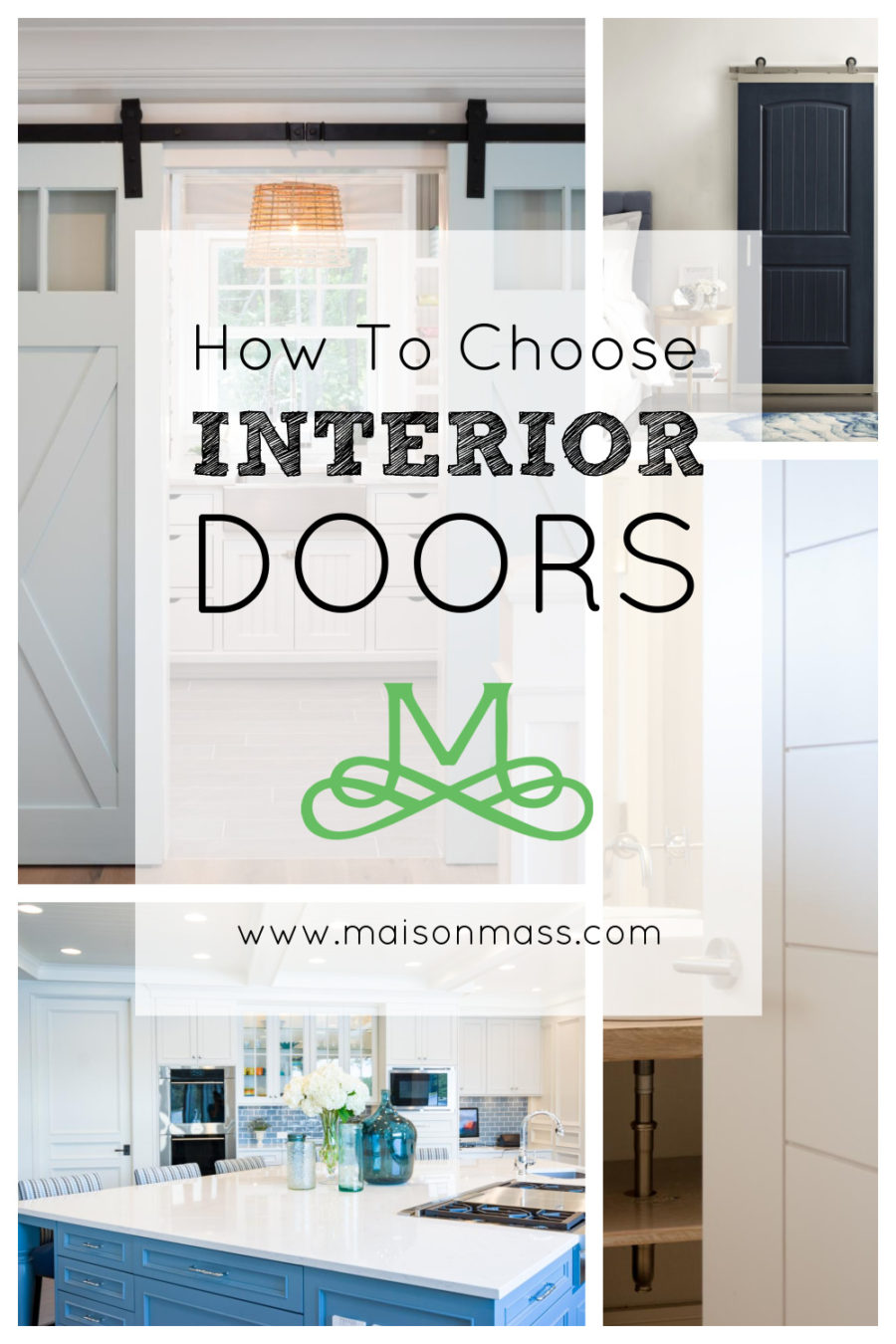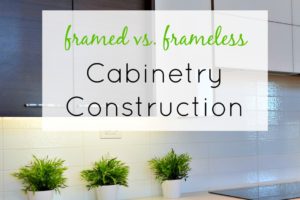Interior doors are the unsung heroes of our homes. It’s true they play many functional roles – they offer privacy, provide sound dampening, and (maybe most importantly!) hide messes. But, they are also a design element that allows you to augment your personal style. Often they are chosen by the contractor when he builds the home – sometimes with little forethought other than cost. If you are lucky enough to have a say in door selection – perhaps you are building a custom home or remodeling – read on to learn how to choose interior doors.
Interior Door Materials
First, let’s look at the different materials used to make doors. In the United States, doors are constructed out of two broad categories of materials: wood or engineered wood products:
Wood
The most common wood interior doors are made from softwood: pine, fir and spruce. But there are hardwood doors as well – mahogany and oak come to mind. More recently, knotty alder has come into fashion for doors for its medium golden color and character.
Engineered wood products
With the cost of wood increasing coupled with the change in trend from stained wood doors and trim to painted trim and doors, the building materials industry looked to other materials for cost savings and manufacturing efficencies. Engineered wood interior doors are made of things like MDF, wood stave, or hardboard.
MDF – is short for medium density fiberboard. It is an engineered wood product that takes wood shavings and sawdust from the manufacture of other products, adds in some resin and wax, and then heat and pressure are applied to create a solid that can be worked like wood: cut, carved, joined, etc. It’s benefits are that it is cheaper than wood, more stable than wood, and is smooth and defect-free (think knots and other imperfections in wood).
Wood stave – this is blocks of wood edge glued together to make a solid and then veneered with MDF (or wood). This process makes the door less prone to warping. Solid core door stiles and rails are often made from wood stave.
Hardboard – also called high density fiberboard is a kind of engineered wood, which is made of steam-cooked and pressure-molded wood fibers in a process patented by William H. Mason.
The first question in answering how to choose interior doors: are you painting the doors, or do you want a natural wood or stained wood door? This will narrow down your options for door material. If you are painting your doors, you should choose engineered materials.
Interior Door Construction
Now that you’ve been introduced to interior door materials, let’s look at construction. Again, over time, new technologies have been employed to create doors more efficiently and cost-effectively resulting in different interior door products in the marketplace. We are going to talk about the three main kinds of interior door construction: molded, traditional stile and rail, molded and router-carved.
Molded Interior Door Construction
Molded interior doors are exclusively made with engineered wood components and are manufactured by two main brands in the United States: Masonite and Jeld-Wen. They are the white, paintable doors you’ll find at big box stores. Molded doors are a production door – they have taken traditional styles of doors and made stamps to create the panel patterns out of a flat piece of what used to be called masonite (a type of hardboard). They build a frame for the door out of pieces of wood and then put the stamped panel on the front and back of the frame. The hollow core versions are just that – the frame and the stamped panels. Then they have a solid core version where they fill the cavity of the frame with particleboard – sawdust mixed with an adhesive – to give the door better sound dampening qualities and make it feel like a real wood door. This is a great, quick overview on the manufacturing process: https://www.youtube.com/watch?
While hollow core and solid core doors look the same from the outside, they aren’t the same from a quality perspective. Hollow core molded doors are considered an entry-level or builder-grade door, are easier to damage, and have poor sound reduction. (Read my opinion on hollow core doors in expensive homese here.)
Stile and Rail Interior Door Construction
Traditionally, doors were made from wood and constructed from pieces of wood called stiles and rails along with panels to create a door style. The pieces of a traditional door are:
Stiles are the vertical pieces of the door
Rails are the horizontal pieces of the door. In some door styles there is a middle rail and this is referred to as the lock rail – the rail where the door knob or lever is installed.
Panels are the panels that fit between the stiles and rails
Sticking is the decorative molding that is sometimes used to trim out where the panels meet the stiles and rails
Today, stile and rail doors are made from wood, MDF, and/or other engineered products. You may hear that higher end residential builders and architects prefer stile and rail doors because molded doors are not architecturally correct. As mentioned above, traditionally doors were made by cutting pieces of wood into stiles, rails and panels and fitting the parts together with dowels. Making doors in this way, yields crisp lines and 90 degree angles where you’d expect them between panels and stiles and rails. Because molded doors are made with a façade of one piece of stamped material, they are rounded and lack definition. Discerning folks would just buy pine doors when the style was stained doors and trim. When the style turned to painted doors and trim, builders would paint the wood doors. But because wood is a natural product, it tends to move quite a bit depending on how humid or dry the environment is. So the panels would expand in the summer and then shrink in the winter when the heat was turned on causing the parts of the door to move and the paint to crack where the parts met. People didn’t like that, so the building industry set about looking to build a better mousetrap. In the late 90’s / early 2000’s TruStile started making doors in the traditional style, but using MDF (medium density fiberboard) instead of wood. Because MDF is an engineered wood product, it is more stable than wood and paints beautifully. In terms of a paint-grade door, an MDF stile and rail door is the best of the best.
The cost of all-MDF stile and rail doors is more than many price points can bear, so industrious folks started looking for efficiencies. Several manufacturers (Frameport, Woodgrain, even Masonite and Jeld-Wen) now make a stile and rail door in what I call a “hybrid” manufacturing process. The panels of these doors are made from MDF, but the stiles and rails are made of wood pieces glued (wood stave) together and covered in an MDF skin. The components (stiles, rails and panels) are all put together in the traditional way so you get the nice architectural detail, but because they don’t use all MDF, they are less expensive. These companies also don’t offer the endless customization of TruStile – they concentrate on mass production of a few popular styles to keep costs down.
Router-carved Interior Door Construction
Router carved doors take a piece of MDF and use a CNC machine to rout out or carve the design into the door. Companies like Millennium Door and Woodgrain offer router carved options. These doors use a thinner piece of MDF for the routed front and backs of the doors and sandwich in other materials to reduce costs. It’s just another method to produce doors to a scale needed to be competitive in today’s building materials market. Millennium (owned by Jeld-Wen) has a good video overview of their process.
Often door construction is determined by your budget. Stile and rail doors are more expensive than molded doors and router carved fall somewhere in between. The price of a door is also influenced by the style of door you choose.
Interior Door Styles
There have never been more comercially available door styles on the market than there are now. Check out the product catalogs here, here and here for a selection. And if you can’t find what you want in a manufacturer’s catalog, you can create a custom design and have it made for you – at a price of course. Here are some general rules for choosing a door style:
Modern/Contemporary Homes – if you have a modern home, you most likely favor very simple, clean lines. Flush doors with no panels, stiles or rails are typically used in these types of homes.
Modern Farmhouse/Transitional – by far the most popular home style today, a good choice for this type of home is a flat panel one, two, three or four panel with square sticking (no molding detail between panels and stiles and rails)
Traditional – for traditional homes or period homes, raised panel doors are most common. Six panel doors with raised panels were historically the most popular door for builders (they were in the home I grew up in built in 1969 and I have them in my home that was buiilt in 1989 and they are still available everywhere today). Today, the most popular raised panel door is the two panel raised.
Well, we totally geeked out on doors, didn’t we? I hope this primer on how to choose interior doors gives you the information you need for the choices in your own home. In my experience, doors are some of the least well understood compenents of a home – even by many builders. If you have any questions or there is something I didn’t cover, please reach out!


















